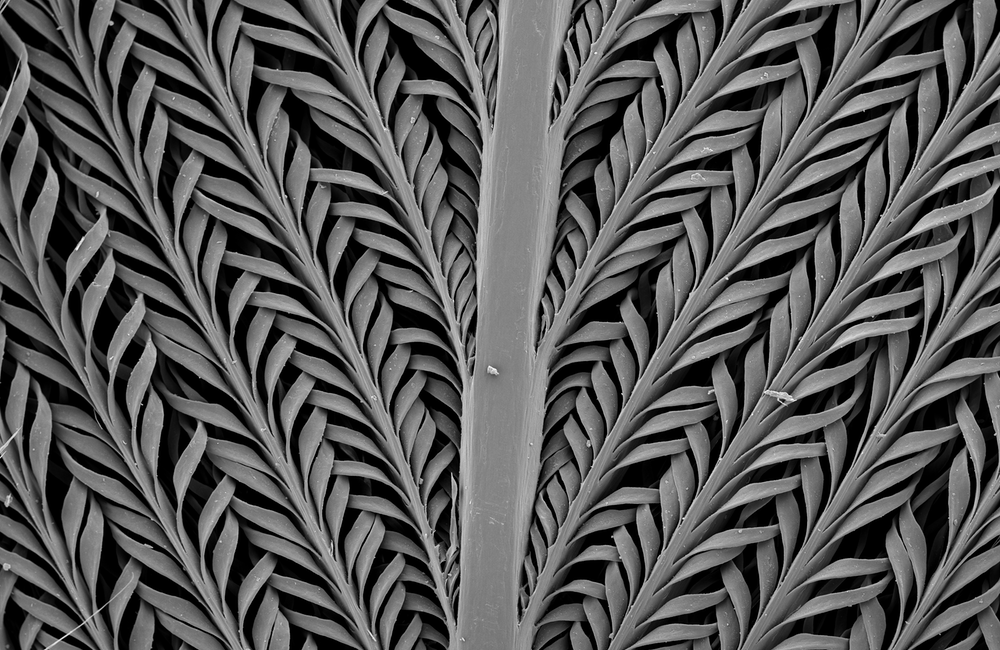Stuffing Water into Bird Feathers
The Namaqua sandgrouse is unusual, when it comes to birds, as its belly feathers are designed to suck water in rather than keep it out. Now Jochen Mueller of Johns Hopkins University, Maryland, and Lorna Gibson of the Massachusetts Institute of Technology have uncovered the details of this water-sucking ability [1]. The results could aid in understanding from an evolutionary perspective how and why these birds developed this ability. The work could also inspire designs of artificial materials that can efficiently store and release water.
“The sandgrouse’s cool water carrying ability always comes up in ornithology classes,” says Allison Shultz, an ornithology curator at the National History Museum of Los Angeles County, which provided feather samples to Mueller and Gibson. “But the mechanism of how it works had never been explored in any detailed way. That makes this new work really exciting,” she says.
In 1896, Edmund Meade-Waldo, a British ornithologist and conservationist, noted an odd behavior among the captive sandgrouse that he was breeding. Male adult birds were waddling down to the water sources in their enclosures, sitting down in that water, and then waddling with swollen bellies over to their young. The chicks would then get under the adult birds’ bellies and put their beaks to the tummy feathers. The dads appeared to be bringing their chicks water to drink.
Meade-Waldo shared the observations with fellow ornithologists, but the idea that sandgrouse chicks “suck the water from [a male bird’s] breast,” as Meade-Waldo wrote, was met with extreme skepticism. “No one believed him,” Mueller says. “It was deemed a crazy behavior.”
Over the next 70 years, other observers provided similar reports, but it wasn’t until 1967 that the idea was given any real credence. Performing experiments with dead sandgrouse specimens and feathers, two biologists at Cornell University found that male sandgrouse could hold in their belly feathers about 15% of their body weight in water. These birds—which live primarily in southwestern Africa—often nest up to 30 km from the nearest watering hole, and the Cornell biologists estimated that a male sandgrouse could retain over half the absorbed water in its feathers during the approximately 30-minute flight between the source and its nest. That left plenty of liquid to give the chicks, who cannot fly for their first month of life.
So how do sandgrouse capture water, keep it in their bellies for long distances, and then release it to their young? The Cornell biologists had some ideas, but without the use of modern technologies, the details remained murky. In their study, Mueller and Gibson took the belly feathers of adult male Namaqua sandgrouse and performed various wetting experiments, as well as structural tests using a scanning electron microscope and a computed tomography machine.
The first thing that the duo noticed was the unusual structure of the feathers—something earlier scientists had documented, but not captured in detail. Like most bird feathers, those of the sandgrouse have a main shaft down the center and a fluffy vane that extends outward. Within this vane are myriad barbs—the individual strands of feather material—which then subdivide into barbules. For a robin, for example, these barbules are straight with a hook at the end. For the sandgrouse, however, Mueller and Gibson observed bent barbules that curl helically for one coil and then extend straight.
When submersed in water, the duo observed that the sandgrouse’s barbules uncoiled, rotating so that that those on opposing barbs overlapped to create a dense “forest” of fibers. Lifting the uncoiled feather out of the water, the barbules retained this forest structure, trapping water on the upper surface. When dried the feather returned to its original state. “The barbule shape change is fully reversible,” Mueller says.
The ability of the barbules to coil and uncoil comes, Mueller says, from their molecular structure. The barbules of bird feathers are made from keratin—the same material in hair and fingernails. In the sandgrouse this keratin exists in both amorphous and crystalline phases. These different phases swell by different amounts when they encounter water, leading to a shape change. “One side of the barbules swells more than the other side, causing this uncurling,” Mueller says.
Calculations by the team show that the water retention ability of the feathers comes from the same surface tension effect seen in capillarity, where water flows up a tube. The space between two barbs acts like a tube that pulls water in and prevents it from sloshing out as the bird flies. “The dimensions of the feather features align with what we’d expect for an optimized design,” Mueller says. “That was a surprise.”
“Some of the really exciting advances in understanding in biology come when people from outside fields, like engineering, come in with a new perspective and the latest and greatest analytical tools,” Shultz says. She notes that prior to learning of this study she would not have thought to have probed the morphology of feathers under water—it’s not a step a curator normally takes. “This work shows the importance of studying objects in the context in which they are being used in nature,” she says.
–Katherine Wright
Katherine Wright is the Deputy Editor of Physics Magazine.
References
- J. Mueller and L. J. Gibson, “Structure and mechanics of water-holding feathers of Namaqua sandgrouse (Pterocles namaqua),” J. R. Soc., Interface. 20 (2023).







